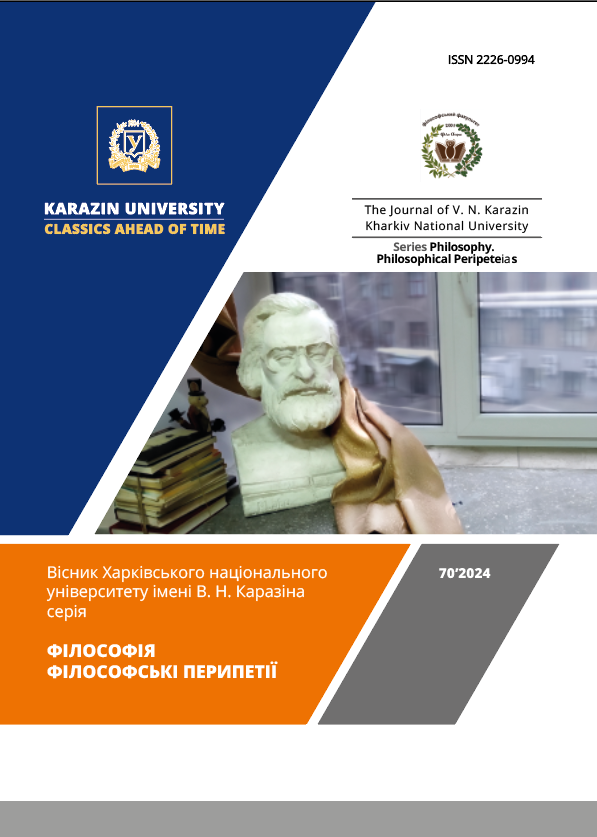SPECULATIVE REALISM AND OBJECT-ORIENTED ONTOLOGY AS POST-POSTMODERN TREND
Abstract
In this article post-postmodern features of speculative realism and object-oriented ontology are considered. The consideration is made through the discovery of postmodern topics in the current eventuality. Accordingly, post-postmodern is understood as a trend in which postmodern develops, partially overcoming itself. Speculative realism and object-oriented ontology are showcased as a mode of modern anthropocentrism resistance. To realize this, the article introduces such a concept as the invividual, which reflects the current state of a human being. It is displayed that just an invividual escapes the correlation between reality and human thought. This prevention of the subject hypotrophy is seen as the condition of humankind’s survival in the urgent eventuality, and the invividual as a hyposubject. The concept of invividual allows displaying post-postmodern ontology, topology, ecology and anthropology in the speculative realism and object-oriented ontology context. Special attention is paid to the turn of ontology to ontology and geometry to topology. In addition, how in this context postmodern interest in the topology turns into post-postmodern interest in the atmosphere, affective landscape, which needs attunement, is researched. The atmospheric in this case is given by a weird, vibrant matter as a matter vital, lively and sprightly, full of energy and life and at the same time quivering, pulsating. Moving from postmodern non-Euclidean topology the peculiarities of speculative realism’s and object-oriented ontology’s topology are studied as post-postmodern. Such a topology describes places, which merge with events, happening there. It includes strange dimensions with a lack of perspective laws atmosphere as an atmosphere of invividual. This atmosphere, environment of plastiglomerates, industrial relics and vaccinated organisms, composited by the encounter of non-human and non-human objects and realizing futurality right now, need special attunement in post-postmodern vein.
Downloads
References
Avanessian, A. & Malik, S. (2016). The Speculative Time Complex. In A. Avanessian & S. Malik (Eds.), The Time Complex: Post-Contemporary, (pp. 5–56). Miami, Florida: [NAME].
Allen, M. (2017–2018). The Inner Life of Things: Object-Oriented Architecture, Programming, and Ontology. Scapegoat: Architecture, Landscape, Political Economy, Issue 11: Life (Winter 2017 – Spring 2018), 108–129.
Baudrillard, J. (2009). Why Hasn’t Everything Already Disappeared? (C. Turner, Trans.). London; New York: Seagull Books. (Original work published 2008).
Bennett, J. (2010). Vibrant Matter: A Political Ecology of Things. Durham, London: Duke University Press.
Blake, T. (2013). Speculative Grace: Misleading Title or Postmodern Program? Agent Swarm, July 12. Retrieved from https://terenceblake.wordpress.com/2013/07/12/speculative-grace-misleading-title-or-postmodern-program/.
Boyer, D., & Morton, T. (2016, January). Hyposubject. Cultural Anthropology, 21. Retrieved from https://culanth.org/fieldsights/hyposubjects.
Brassier, R. (2011). Concepts and Objects. In L. Bryant, N. Srnicek & H. Graham Harman (Eds.), The Speculative Turn: Continental Materialism and Realism, (pp. 47–65). Melbourn: re.press.
Brassier, R., Grant, I. H., Harman, G., Meillassoux Q. (2007). Speculative Realism. Collapse, Vol. III, 307–449.
Bratton, B. H. (2016). On Speculative Design. In A. Avanessian & S. Malik (Eds.), The Time Complex: Post-Contemporary, (pp. 57–88). Miami, Florida: [NAME]. Retrieved from http://dismagazine.com/discussion/81971/on-speculative-design-benjamin-h-bratton/
Brown, B. (2015). Other Things. Chicago and London: The University of Chicago Press.
Bryant, Levi R. (2008). Difference and Givenness: Deleuze’s Transcendental Empiricism and the Ontology of Immanence. Evanston, IL: Northwestern University Press.
Bryant, Levi R. (2011). The Democracy of Objects. Ann Arbor: Open Humanities Press.
Bryant, L., Srnicek, N. & Harman, G. (2011). Towards a Speculative Philosophy. In L. Bryant, N. Srnicek & H. Graham Harman (Eds.), The Speculative Turn: Continental Materialism and Realism, (pp. 1–18). Melbourn: re.press.
Cogdell, Ch. (2018). Toward a Living Architecture? Complexism and Biology in Generative Design. Minneapolis, London: University of Minnesota Press.
Crouzet, L. (2020). Mount of Things: An Expedition in Object-Oriented Ontology Architecture. Vancouver: The University of British Columbia, Canada.
Dubey, M. (2011). Post-postmodern realism? Twentieth Century Literature, vol. 57, issue 3–4 (Fall–Winter), 364–371.
Hosford, C. (2011). Faking Jazz Together [Recorded by Connan Mockasin]. On Forever Dolphin Love [CD]. Paris: Because Music; London: Phantasy Sound.
Lyotard, J.-F. (1991). The Inhuman: Reflections on Time. (G. Bennington & R. Bowlby, trans.). Stanford, CA: Stanford University Press. (Original work published 2008).
Moran, T. & Miller, M. (2016) Post Rock. Retrieved from https://taubmancollege.umich.edu/research/research-through-making/2016/post-rock
Morton, T. (2018). Being Ecological. Cambridge, Massachusetts: MIT Press.
Morton, T. (2013). Hyperobjects. Philosophy and Ecology after the End of the World. Minneapolis, London: University of Minnesota Press.
Negarestani, R. (2018). The Inhuman (a quick read). Toy philosophy, April 8. Retrieved from https://toyphilosophy.com/2018/04/08/the-inhuman-a-quick-read/
Niemoczynski, L. (2017). Speculative Realism: An Epitome. Leeds: Kismet Press.
Pell, R. W. in conversation with Kutil E. & Turpin E. (2015). PostNatural Histories. In H. Davis & E. Turpin E. (Eds.), Art in the Anthropocene (Encounters Among Aesthetics, Politics, Environments and Epistemologies), (pp. 299–316). London: Open Humanities Press.
Srnicek, N. & Williams, A. (2015). Inventing the future: postcapitalism and a world without work. London: Verso.
Thacker, E. (2011). In the Dust of This Planet. Winchester, Washington: Zer0 Books.
Thacker, E. (2015). Tentacles Longer Than Night. Winchester, Washington: Zer0 Books.
Trigg, D. (2022). Introduction: Atmospheres of shared emotion. In D. Trigg (Ed.) Atmospheres and Shared Emotions. Ambiances (Atmospheres and Sensory Experiences of Spaces), (pp. 1–14). London: Routledge. DOI: 10.4324/9781003131298-1
Trigg, D. (2014). The Thing: A Phenomenology of Horror. UK: Zero Books, 2014.
Woodard, B. & Marhulets D. (2019, June 22). Brilliant Darkness. Philosophy and Art at the Edge of the Human # 4. [Video]. YouTube. https://www.youtube.com/watch?v=hnOh_NccF8c&ab_channel=DamianMarhulets
Žižek, S. & Woodard, B. (2011). Interview. In L. Bryant, N. Srnicek & H. Graham Harman (Eds.), The Speculative Turn: Continental Materialism and Realism, (pp. 406–415). Melbourn: re.press.
Copyright (c) 2024 Наталія Загурська

This work is licensed under a Creative Commons Attribution 4.0 International License.
Authors who publish with this journal agree to the following terms:
- Authors retain copyright and grant the journal right of first publication of this work under the terms of a license Creative Commons Attribution License 4.0 International (CC BY 4.0).
- Authors are able to enter into separate, additional contractual arrangements for the non-exclusive distribution of the journal's published version of the work (e.g., post it to an institutional repository or publish it in a book), with an acknowledgement of its initial publication in this journal.
- Authors are permitted and encouraged to post their work online (e.g., in institutional repositories or on their website) prior to and during the submission process, as it can lead to productive exchanges, as well as earlier and greater citation of published work.






3.gif)




